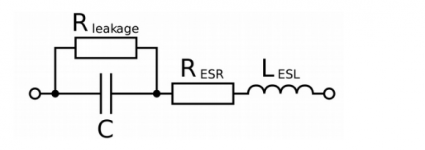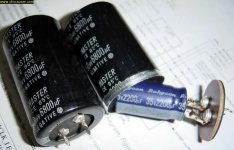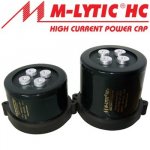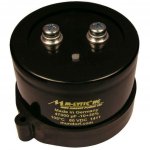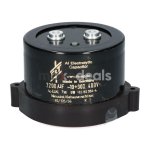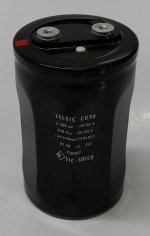nope is ,is non lineary read thdIf a cap is modifying the sound then its faulty.
So, in other words... faulty.nope is ,is non lineary read thd
https://www.neumann.com/homestudio/en/what-is-a-condenser-microphoneSo, in other words... faulty.
Attachments
yes.Manufacturers could make more money by focusing their efforts elsewhere.
Tom
Attachments
thank you for this advice. I ask for an offer of 10.000uF/80V (40x63mm)Ref post 2269 above - Hi 'tiefbassuebertr'
Those Supertech caps that you're looking for (4TTN and 2TN) are available direct from "DNM Design" in the UK (www.dnm.co.uk) - I think there's a distributor for these in Germany (reson audio gmbh) - you can get them from the Hifi Collective in the UK too but not cheap. They were originally made by BHC for Denis Morecroft of DMN Design but now by Supertech in Taiwan - excellent devices.
http://www.dnm.co.uk/acatalog/CapacitorShop.html
and will order additional this elcap with screw terminals from FTcap (40x80mm)
https://kondensatoren-shop.de/epage...a-ee3b-4baa-8f04-14ec4eaa05fc/Products/700212
In general - best capacitors for power supplies in power amplifiers always between 63V and 100V versions. Best brands from my views are this:
1) ft-cap GW series
https://www.ftcap.de/fileadmin/user...xen/Gewindeanschluss/GW_series_16.11.2016.pdf
2) Mundorf M-Lytic
https://www.hificollective.co.uk/components/mundorf_mlytic_hcplus.html
3) SicSafco FELSIC I-PLUS
https://exxelia.com/en/product/detail/73/felsic-105-lp
https://exxelia.com/en/product/detail/78/felsic-i-plus
Unfortunately, for reasons of space, it cannot be used as a replacement part.
I. e. only for use in large outdoor power supplies that are manufactured afterwards but blown away regarded sonic performance (in all respects) any elcap with solder pin and most elcap with screw terminals from other companies like e.g. BC, Nippon, Rubicon, ELNA, RIFA Kendeil.
The old brand S+M - also excellent sonic results - unfortunately don't exist anymore
Including the transformer and filter choke, power supply can quickly cost 4-5 times as much as the power amplifier that is later connected to it - but it's definitely worth it.
Everyone who has done this and made no mistakes in wiring has confirmed the drastic increase in sound quality.
A SMPS (SPS) with same performance I haven't discover until now.
Attachments
Last edited:
Uhhh... OK. Which relates to the topic somehow?
I'm curious what your point is.yes.
I'm as disgusted as you are about the fakes out there.
My point was that manufactures cater to the large customers who spend $M/year not to the DIYer who expects free samples. If the fancy caps sell in large quantities, they'll be kept around. With limited production capacity and raw material availability it's a pretty simple business decision to spend those resources in ways that optimize revenue rather than optimizing for DIYer happiness. That also optimizes the chances that the good capacitor manufacturers will be around next year, which, I think, is to the DIYers' benefit.
Tom
caps are microphonics too?!Uhhh... OK. Which relates to the topic somehow?
I'm curious what your point is.
I'm as disgusted as you are about the fakes out there.
My point was that manufactures cater to the large customers who spend $M/year not to the DIYer who expects free samples. If the fancy caps sell in large quantities, they'll be kept around. With limited production capacity and raw material availability it's a pretty simple business decision to spend those resources in ways that optimize revenue rather than optimizing for DIYer happiness. That also optimizes the chances that the good capacitor manufacturers will be around next year, which, I think, is to the DIYers' benefit.
Tom
True but at the same time they can get some money from us or potentially nothing. There are caps that simply can't be replaced and if it boiled down to it someone would start manufacturing a replacement themselves. Pains of learning to make something or giving up on audio?
The days of pride of providing good parts by larger manufacturers may be dwindling some as the old people at the places may no longer care about anything but profit.
The "some" part is the problem. The member list on DIY Audio contains 17806 members. How many of these do you think are actively working on projects? 10%? 20%? 25%? Of those who are working actively on a project, how many do you think will buy audiophile capacitors?True but at the same time they can get some money from us or potentially nothing.
If, say, 20% of the DIY Audio members are actively building projects and 20% of those use audiophile capacitors, that's 712 members who use audiophile capacitors. Let's just for argument's sake say that they all build one project per year and spend $100/each on audiophile capacitors. That's a total revenue (at the distributor level) of $71200/year.
The distributor takes their cut. I have no idea what the margin is for audiophile capacitors, but let's get an idea of what distributor margins could be. Digikey charges $4.2592/each for the OPA1612AIDR at QTY 1000. TI sells them on their website for $2.662/each (again, QTY 1k). So let's assume that Digikey pay the price on TI's website. They probably get a better deal, but let's just play with the numbers here. That means TI gets 2.662/4.2592 = 0.625 or 62.5% of the distributor revenue.
Assuming the margin on audiophile capacitors is the same as on the OPA1612AIDR, this means that the capacitor manufacturer receives a revenue of 0.625*71200 = $44500/year on the sale of audiophile capacitors to DIY Audio members who actively build projects using audiophile capacitors.
$44.5k/year of revenue before tax doesn't even pay for one employee. I doubt it would even pay for the rebadging of regular capacitors as audiophile capacitors. The cost of creating and maintaining inventory is not zero...
Sometimes it's better to kill a product line than it is to receive "some money" for it. Especially if "some money" doesn't pay for the cost of keeping the product line running. Also, business owners take risk when they invest in product lines. They expect a positive return on their investment. Breaking even is not a good business strategy.
Tom
Of course the readers are many more than the members and audio related sites are multiple. Then there is the refurbishing of vintage gear sold online and in stores, also the newly made audiophile products needs. In any case its a niche market vs the general electronics industry.
Hi Nick nice to see youOf course the readers are many more than the members and audio related sites are multiple. Then there is the refurbishing of vintage gear sold online and in stores, also the newly made audiophile products needs. In any case its a niche market vs the general electronics industry.
I agree with all of that. But not all of those who build, refurbish, fix, etc. use audiophile components. So audiophile components remains a niche market within a niche market.Of course the readers are many more than the members and audio related sites are multiple. Then there is the refurbishing of vintage gear sold online and in stores, also the newly made audiophile products needs. In any case its a niche market vs the general electronics industry.
Tom
The "some" part is the problem. The member list on DIY Audio contains 17806 members. How many of these do you think are actively working on projects? 10%? 20%? 25%? Of those who are working actively on a project, how many do you think will buy audiophile capacitors?
If, say, 20% of the DIY Audio members are actively building projects and 20% of those use audiophile capacitors, that's 712 members who use audiophile capacitors. Let's just for argument's sake say that they all build one project per year and spend $100/each on audiophile capacitors. That's a total revenue (at the distributor level) of $71200/year.
The distributor takes their cut. I have no idea what the margin is for audiophile capacitors, but let's get an idea of what distributor margins could be. Digikey charges $4.2592/each for the OPA1612AIDR at QTY 1000. TI sells them on their website for $2.662/each (again, QTY 1k). So let's assume that Digikey pay the price on TI's website. They probably get a better deal, but let's just play with the numbers here. That means TI gets 2.662/4.2592 = 0.625 or 62.5% of the distributor revenue.
Assuming the margin on audiophile capacitors is the same as on the OPA1612AIDR, this means that the capacitor manufacturer receives a revenue of 0.625*71200 = $44500/year on the sale of audiophile capacitors to DIY Audio members who actively build projects using audiophile capacitors.
$44.5k/year of revenue before tax doesn't even pay for one employee. I doubt it would even pay for the rebadging of regular capacitors as audiophile capacitors. The cost of creating and maintaining inventory is not zero...
Sometimes it's better to kill a product line than it is to receive "some money" for it. Especially if "some money" doesn't pay for the cost of keeping the product line running. Also, business owners take risk when they invest in product lines. They expect a positive return on their investment. Breaking even is not a good business strategy.
Tom
I wasn't referring to audiophile specific ones. And Salas is right about it being much wider, along with every commercial audio product using a lot of the capacitors we use.
The DNM & BHC are now Kemet ALC10S.
This is not an endorsement, just info.
This is not an endorsement, just info.
First, make sure voltage and capacity are as required. Then, some caps come in great colours, so pick the ones that fit the overall picture best.A question for the True Believers - any recommendations on electrolytic decoupling caps for the +/- analog supplies of a NOS PCM63 DAC I am making? If no, I will just use Silmic II.
It may not matter inside of an enclosed DAC, but on vintage gears that expose their guts, I find the color of most of the modern caps distasteful.... some caps come in great colours...
I'm fixing up a Leak ST-60 (don't like the way it sounds in its original form) in dark grey, and the only suitable candidates are EPCOS/TDK, Kemet, F&T, and borderline, Nichicon: they come in black with gold or silver lettering. Luckily, they are all OK-ish sound wise.
- Home
- Design & Build
- Parts
- Best electrolytic capacitors
